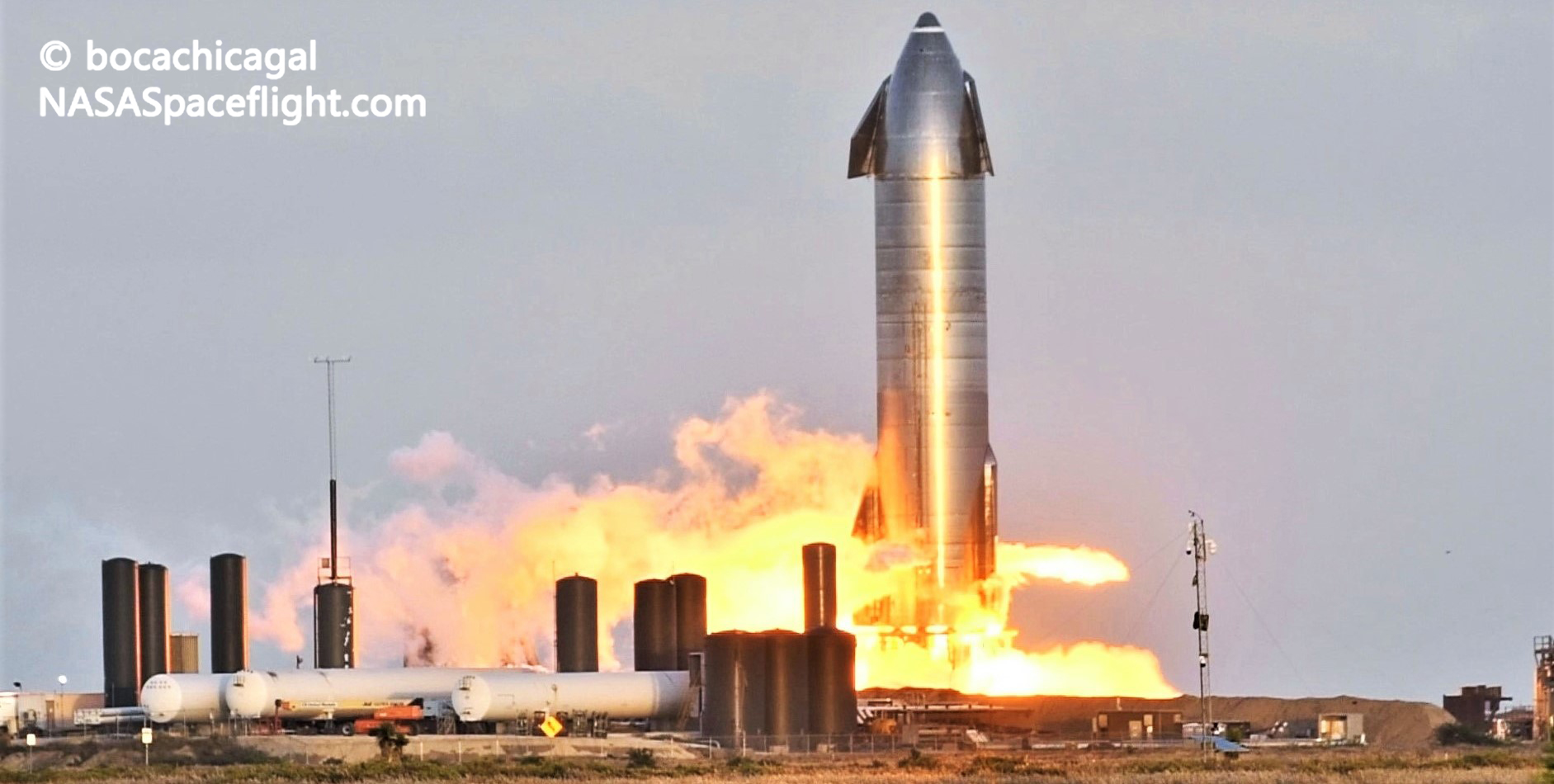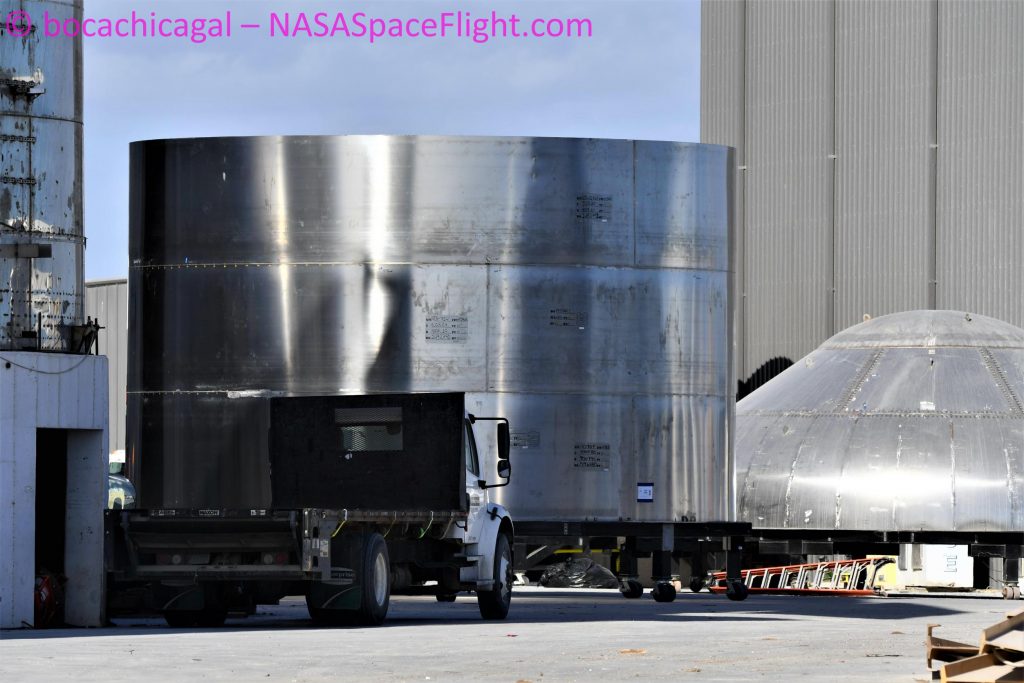

News
SpaceX ‘go’ for 50,000-foot Starship launch debut after static fire, Elon Musk says
CEO Elon Musk says that SpaceX’s first fully-assembled Starship prototype is on track for its 15-kilometer (~50,000 ft) launch debut after completing a second three-engine static fire test on Tuesday.
Starship serial number 8’s (SN8) three Raptor engines ignited for a few seconds around 5:30 pm CST (UTC-6) on Tuesday, November 24th, less than four hours before a record-breaking Falcon 9 rocket launched another batch of Starlink satellites roughly a thousand miles to the east. Perhaps briefly producing upwards of 600 metric tons (6000 kN/~1.3M lbf) of thrust, Starship SN8’s second triple-engine static fire was actually the first with that particular trio of engines.
Back on November 13th, an otherwise successful one or two-engine static fire nearly ended in catastrophe when the hypersonic Raptor exhaust kicked up blade-like debris that severed crucial control cables and triggered an apparent engine meltdown. Thanks to a “burst disk” failsafe, Starship SN8 – unable to actuate valves needed to depressurize – was saved from what could have been catastrophic damage. Believed to be SN32, the damaged Raptor was subsequently removed on November 14th and replaced with SN42 on November 16th.
As such, SN8’s November 24th static fire was the first with that particular set of three engines, although it was technically the rocket’s second three-engine test. SN42 now (hopefully) proven to be flight-ready, it remains to be seen if SpaceX will attempt more static fires before Musk’s promised 15 km launch debut.
As of November 25th, SpaceX still has a static fire backup window open open from 8 am to 5 pm CST, while Starship SN8’s launch road closures remain in effect from 7 am to 6 pm on November 30th with backups from 8 am to 5 pm on December 1st and 2nd.
Having now spent more than a month at the launch pad, it’s increasingly unlikely that SpaceX will continue to choose caution first for upcoming Starship SN8 tests. As Musk recently noted and easily visible from public roads, SpaceX’s Boca Chica factory is developing an extraordinary backlog of giant steel rockets. Just today, November 25th, Starship SN9 (featuring “small improvements”) was stacked to its full 50-meter (~165 ft) height after SpaceX kicked off nose section installation. In simpler terms, if SN8 is destroyed during testing, Starship SN9 will likely be ready to roll to the launch site almost as soon as the pad is clear.
Meanwhile, Starship SN10 is likely just 7-10 days away from a similar nosecone stacking milestone and Starship SN11’s tank section is just one stack away from completion, likely putting it less than two weeks behind SN10. In other words, insofar as speed is a priority and each prototype is anywhere close to as cheap as Starship’s majority-steel bill of materials might suggest, SpaceX is building the rockets so quickly that it almost doesn’t make sense to spend more than a few weeks working through any given ship’s bugs for as long as prototypes remain firmly suborbital.

Musk also says that Starship SN15 will be the host of some mysterious “major upgrades”, likely implying some substantial manufacturing improvements and design refinements. Given that large portions of Starship SN15 (and likely SN16, too) are already visibly in work in Boca Chica, it makes even less sense to spend outsized amounts of time on a much earlier prototype.
It doesn’t come as a huge surprise, then, that Musk has given SN8 – warts and all – a 33% chance of successfully launching, ‘skydiving’ back to Earth, reigniting one or more Raptors, and landing in one piece. The only real certainty is that regardless of the outcome, Starship’s high-altitude launch debut is guaranteed to be spectacular. Stay tuned for updates as we get closer to SpaceX’s November 30th target.

News
Tesla (TSLA) receives “Buy” rating and $551 PT from Canaccord Genuity
He also maintained a “Buy” rating for TSLA stock over the company’s improving long-term outlook, which is driven by autonomy and robotics.

Canaccord Genuity analyst George Gianarikas raised his Tesla (NASDAQ:TSLA) price target from $482 to $551. He also maintained a “Buy” rating for TSLA stock over the company’s improving long-term outlook, which is driven by autonomy and robotics.
The analyst’s updated note
Gianarikas lowered his 4Q25 delivery estimates but pointed to several positive factors in the Tesla story. He noted that EV adoption in emerging markets is gaining pace, and progress in FSD and the Robotaxi rollout in 2026 represent major upside drivers. Further progress in the Optimus program next year could also add more momentum for the electric vehicle maker.
“Overall, yes, 4Q25 delivery expectations are being revised lower. However, the reset in the US EV market is laying the groundwork for a more durable and attractive long-term demand environment.
“At the same time, EV penetration in emerging markets is accelerating, reinforcing Tesla’s potential multi‑year growth runway beyond the US. Global progress in FSD and the anticipated rollout of a larger robotaxi fleet in 2026 are increasingly important components of the Tesla equity story and could provide sentiment tailwinds,” the analyst wrote.
Tesla’s busy 2026
The upcoming year would be a busy one for Tesla, considering the company’s plans and targets. The autonomous two-seat Cybercab has been confirmed to start production sometime in Q2 2026, as per Elon Musk during the 2025 Annual Shareholder Meeting.
Apart from this, Tesla is also expected to unveil the next-generation Roadster on April 1, 2026. Tesla is also expected to start high-volume production of the Tesla Semi in Nevada next year.
Apart from vehicle launches, Tesla has expressed its intentions to significantly ramp the rollout of FSD to several regions worldwide, such as Europe. Plans are also underway to launch more Robotaxi networks in several more key areas across the United States.
News
Waymo sues Santa Monica over order to halt overnight charging sessions
In its complaint, Waymo argued that its self-driving cars’ operations do not constitute a public nuisance, and compliance with the city’s order would cause the company irreparable harm.

Waymo has filed a lawsuit against the City of Santa Monica in Los Angeles County Superior Court, seeking to block an order that requires the company to cease overnight charging at two facilities.
In its complaint, Waymo argued that its self-driving cars’ operations do not constitute a public nuisance, and compliance with the city’s order would cause the company irreparable harm.
Nuisance claims
As noted in a report from the Los Angeles Times, Waymo’s two charging sites at Euclid Street and Broadway have operated for about a year, supporting the company’s growing fleet with round-the-clock activity. Unfortunately, this has also resulted in residents in the area reportedly being unable to sleep due to incessant beeping from self-driving taxis that are moving in and out of the charging stations around the clock.
Frustrated residents have protested against the Waymos by blocking the vehicles’ paths, placing cones, and “stacking” cars to create backups. This has also resulted in multiple calls to the police.
Last month, the city issued an order to Waymo and its charging partner, Voltera, to cease overnight operations at the charging locations, stating that the self-driving vehicles’ activities at night were a public nuisance. A December 15 meeting yielded no agreement on mitigations like software rerouting. Waymo proposed changes, but the city reportedly insisted that nothing would satisfy the irate residents.
“We are disappointed that the City has chosen an adversarial path over a collaborative one. The City’s position has been to insist that no actions taken or proposed by Waymo would satisfy the complaining neighbors and therefore must be deemed insufficient,” a Waymo spokesperson stated.
Waymo pushes back
In its legal complaint, Waymo stated that its “activities at the Broadway Facilities do not constitute a public nuisance.” The company also noted that it “faces imminent and irreparable harm to its operations, employees, and customers” from the city’s order. The suit also stated that the city was fully aware that the Voltera charging sites would be operating around the clock to support Waymo’s self-driving taxis.
The company highlighted over one million trips in Santa Monica since launch, with more than 50,000 rides starting or ending there in November alone. Waymo also criticized the city for adopting a contentious strategy against businesses.
“The City of Santa Monica’s recent actions are inconsistent with its stated goal of attracting investment. At a time when the City faces a serious fiscal crisis, officials are choosing to obstruct properly permitted investment rather than fostering a ‘ready for business’ environment,” Waymo stated.
News
Tesla FSD v14.2.2 is getting rave reviews from drivers
So far, early testers have reported buttery-smooth drives with confident performance, even at night or on twisty roads.

Tesla Full Self-Driving (Supervised) v14.2.2 is receiving positive reviews from owners, with several drivers praising the build’s lack of hesitation during lane changes and its smoother decision-making, among others.
The update, which started rolling out on Monday, also adds features like dynamic arrival pin adjustment. So far, early testers have reported buttery-smooth drives with confident performance, even at night or on twisty roads.
Owners highlight major improvements
Longtime Tesla owner and FSD user @BLKMDL3 shared a detailed 10-hour impression of FSD v14.2.2, noting that the system exhibited “zero lane change hesitation” and “extremely refined” lane choices. He praised Mad Max mode’s performance, stellar parking in locations including ticket dispensers, and impressive canyon runs even in dark conditions.
Fellow FSD user Dan Burkland reported an hour of FSD v14.2.2’s nighttime driving with “zero hesitations” and “buttery smooth” confidence reminiscent of Robotaxi rides in areas such as Austin, Texas. Veteran FSD user Whole Mars Catalog also demonstrated voice navigation via Grok, while Tesla owner Devin Olsen completed a nearly two-hour drive with FSD v14.2.2 in heavy traffic and rain with strong performance.
Closer to unsupervised
FSD has been receiving rave reviews, even from Tesla’s competitors. Xpeng CEO He Xiaopeng, for one, offered fresh praise for FSD v14.2 after visiting Silicon Valley. Following extended test drives of Tesla vehicles running the latest FSD software, He stated that the system has made major strides, reinforcing his view that Tesla’s approach to autonomy is indeed the proper path towards autonomy.
According to He, Tesla’s FSD has evolved from a smooth Level 2 advanced driver assistance system into what he described as a “near-Level 4” experience in terms of capabilities. While acknowledging that areas of improvement are still present, the Xpeng CEO stated that FSD’s current iteration significantly surpasses last year’s capabilities. He also reiterated his belief that Tesla’s strategy of using the same autonomous software and hardware architecture across private vehicles and robotaxis is the right long-term approach, as it would allow users to bypass intermediate autonomy stages and move closer to Level 4 functionality.








